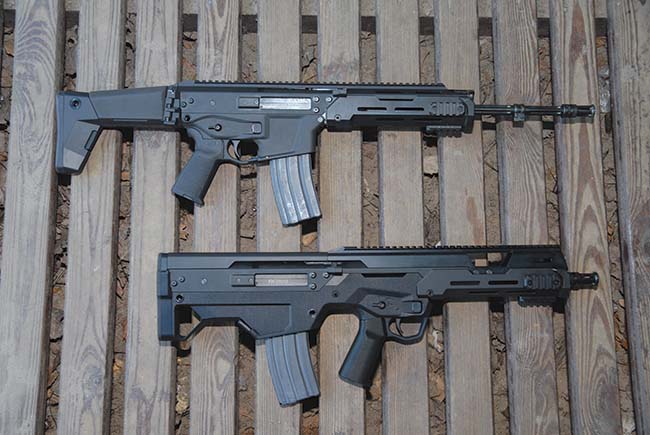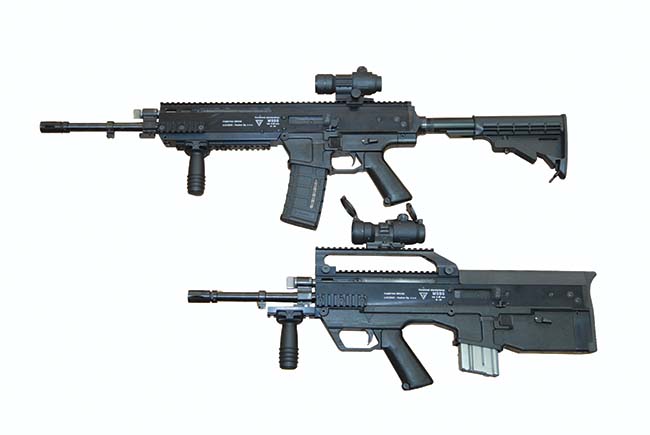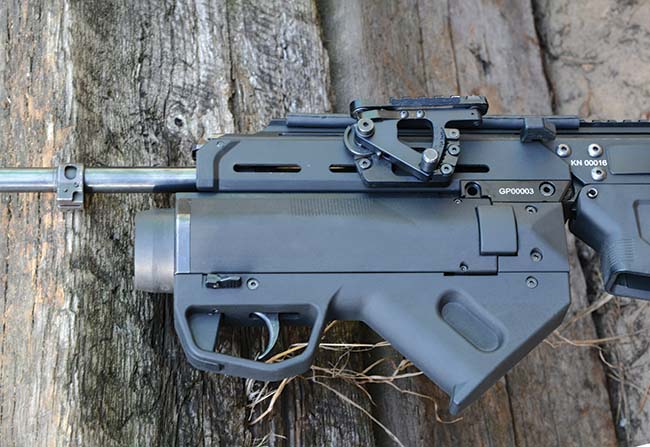ABOVE: Norbert Piechota of FB Radom demonstrates the MSBS-5.56B rifle. Note the steadiness of the weapon in full-auto firing: two cases are already flying, the third is about to be ejected, and the muzzle is still perfectly stable, no blurring at all.
The Modular Small Arms System 5.56mm (Polish: Modulowy System Broni Strzeleckiej 5.56mm, MSBS-5.56) was initiated in December 2007, as a joint R&D program of the Warsaw-based Military Technology University’s (WAT) Department of Special Technologies with Radom’s Fabryka Broni.
The project aimed to develop, build and test a modular 5.56mm family of rifles within four years, up until 2010. Perhaps for the first time ever in the history of Polish arms design, the creators of the rifles polled a very wide circle of experts and end-users, both military and civilian, including the shooting media, for opinions concerning both the general layout and design details of the future Polish Army’s battle rifle.

The tactical and technical requirements (TTR) and initial design were ready by the end of 2008, as well as mock-ups of the Technology Demonstrators (TDs). In 2009, the actual functional model TDs were built, and tested in early 2010, after which they were first publically presented (earlier presentation were media-only) at the September 2010 MSPO defense fair in Kielce. The remainder of the time was used for test results analysis. At that point readers of the Polish STRZAL gun magazine were polled to come up with the name for the new rifle, and the winner was Radon – hinting at both Radom and the tradition of using chemical elements as names (radon, Rn, is a radioactive gas, atomic number 86).
Unfortunately, the Polish military, seemingly the most concerned entity, in fact proved to be the least interested in the new rifle. They dragged their feet at every stage, and merely tolerated the MSBS project as a tool to extract money from the government to finance the military R&D centers involved. In the brass’ expert opinion, the Beryl rifle was still going strong, and the fact that it was based on a 60+ year old design was the least of generals’ worry. Their view was, “Yes, it might be getting a tad obsolescent, but we’re going to retire before it turns obsolete – so why bother?” When most of them were Lieutenants or Captains, the army was already ‘not winning wars with mere rifles’. That mindset started to change with the influx of young blood with first-hand asymmetrical warfare experience of Iraq and Afghanistan – but alas, the junior officers from Divaniya or Ghazni, sorely aware that in the new Millennium the rifle is again the infantryman’s main tool of trade, are still a long way from the
General Staff.

New Opening
The TDs were ugly. Being just what they were called – technology demonstrators – they were to be efficient rather than eye-catching, like lab appliances. After the innards were more or less sorted out, now came the time for the looks. This was about to change a great deal, as the industrial design panel was organized at the WAT. The result was far from a simple paint job; the rifle was in fact redesigned from scratch. Hardly a part of the rifle survived intact from the initial design. Several months of hard work and several dozen mock-ups later, the final, much more pleasing to the eye and less offending to human ergonomics Radon mock-ups were justifiably proudly presented in August, 2010. The immediate reaction was mixed – some reviewers found it too much resembling the ACR for comfort. When you feed the same requirements to the same design-support software, they tend to come up with designs much like each other.
Inside the new design was as distant from the old TDs as they were on the outside. To accommodate the new design, many internals were reworked from the start. The bolt carrier morphed from a SCAR-style big, long affair with integral operating rod and fitted with dual cams for changing the ejection direction into a compact box with a single cam path for operating a cam pin – on whatever side the empties fly.

The MSBS-5.56 project was to spawn a total of 11 variants, five in classic configuration (standard rifle, grenade launching rifle, carbine, LMG, DMR) and five bull-pup equivalents, plus MSBS-R, a fixed-stock ceremonial rifle for the Polish Army’s Honor Guard Battalion. For the grenade launching rifle, or 5.56 / 40mm combo, a new MSBS-specific grenade launching module, conforming to the MSBS design was created. Additionally a 12-ga military shotgun based on the MSBS-5.56 is contemplated, but so far still on paper – or rather, computer screen stage.
This duality of configuration is mirrored by dividing the design team into two centers: the ‘dash K’ team at the WAT under Col. Miroslaw Zahor and the ‘dash B’ team in Radom, headed by Krzysztof Koziel and Norbert Piechota.
How the Radon Functions
Although there seems to be little revolutionary stuff in the MSBS (as with most recent assault rifles), it’s the small details that make up the masterpiece. The designers applied for 7 patents and 11 utility models in the process. This article is the first time we are able to come up with any details.

The 5.56mm MSBS-5.56 Radon rifle is an individual selective-fire, gas-operated weapon, in two basic configurations, the MSBS-5.56K/Radon-K (classical) and MSBS-5.56B/Radon-B (bull-pup). The Radon-K with its side-folding LOP-adjustable stock is the basic variant of the family. The bull-pup Radon-B shares the complete upper receiver with the K, substituting the B-specific lower receiver. Both rifles have the same internal design, while of course the B rifle is much more compact. Thanks to the modular design, each K rifle can be converted to a B rifle (and vice versa) in seconds as the barrels are exchangeable for different length or contour, and ejection direction can be changed at field-strip level. So far, that seems redundant, as even with the right side ejection, the bull-pup rifle can be safely fired from the left shoulder. The brass flies downwards and to the front.
The Radon’s gas system uses a short-stroke piston traveling just 17 mm (.67-in). An operating rod transfers the impulse to the bolt carrier, which starts an automatic cycle, familiar to anyone who ever fired an external piston-driven AR platform. The main difference is that the return spring is placed within the upper receiver – enabling the stock to fold. The bolt locks always turning to the right, regardless of ejection direction.
The ambidextrous bolt catch paddles are placed on either side of the trigger guard, acting on a vertical bolt hold open shaft. The magazines are STANAG 4179-compatible, but in the most recent version an extended flared magazine well mouth would conflict with the Betamags – even though quad-row SureFire 60s and 100s would fit it for LMG work. The barrels are 6-groove, 1:7 inch RHT, as they are chambered for the STANAG 4172-compatible rounds. They easily change in the field (as opposed to QCB) thanks to a clever barrel vise installed inside the trunnion. That consists of two parallel wedges, set on the shared Roman-screw – no matter on which side of the trunnion it is turned (by hex key), the wedges move in reciprocating directions at the same time and rate, freeing or latching the barrel (actually held by the trunnion, the wedges just hold it there) without the need for torque-wrenches and all. How’s that versus the FN SCAR with eight screws to be turned in exact order and to exact torque? Several different profiles of the barrels were tested, in two lengths, 16 inches for the rifle and 12 inches for carbine, fluted and plain, with a thicker contour plain barrel planned for DMR or LMG variants.

Totally Ambidextrous
The MSBS-5.56 is totally ambidextrous. All controls are doubled, or placed as to allow actuating with either hand (Radon-B bolt catch). The cocking handle is non-reciprocating, but allows manual bolt assist. It is placed inside the upper receiver, with triangular ‘winglets’ slouching to clear the top-rail mounted sights. Brass may be ejected to either side, by a clever arrangement of the bolt. The cam pin channel in the bolt is perpendicular to the extractor – ejector plane. To change the ejection direction all one has to do is rotate the bolt by 180 degrees. To accommodate the upper receiver to that change, you have to use a hex key (Torx blade to be precise) to unbolt the active brass deflector and exchange it for cover, blocking the other ejection opening. The new bolt carrier has only got one cam path, and the cam pin head is beveled to allow it to clear the return spring running on the top.
The bolt is rather AR-ish than the old AK-based bolt of the Beryl. It has 7 lugs with an eighth being a stump on the extractor. The ejector is a typical AR spring-loaded one.
The return spring is captive – held semi-contracted on a hollow spring guide and comes off as a single unit, making field stripping easier.

Fire Control Group
The hammer mechanism is generally along the lines of the AR-15, with the exception of a different automatic sear. The mechanism itself is encased in a metal container inserted into the polymer lower receiver to avoid setting hard steel pins directly in soft plastic to give them ample support and to prevent key-holing the pin sockets. The FCG packet is held inside lower receiver by safety-selector axis and magazine catch. This kind of modular design of course invites the civilian-legal semi-only modifications, basing on existing parts. The semi-only civilian FCG has not yet been designed (the military model is a priority) and it is the opinion of the design team, that civilian FCGs should be rather directly along the AR lines, both to encourage use of COTS tuning components and to avoid legal problems with selective and semiautomatic mechanisms being fully exchangeable. The recent iteration of the lower receiver has a fully exchangeable pistol grip, to allow individualization with the use of the COTS components.
Stock
The length-of-pull stock adjustment should satisfy most shooters whether wearing ballistic protection or not. The stock itself offers a very good positioning on the shoulder, stable, with a much purchase and cheek weld, as well as an adjustable cheek pad. The rifle can be fired with the stock folded as the controls and ejection opening are cleared. The rifle is very stable, both in semi and auto mode.

The adjustment period to the ‘dash K’ rifle may vary in length, the shortest one would probably be from AR platform – but still the bolt catch is very different. The bull-pup is so much a different weapon, that the period of adjustment seems more obvious than in the case of the MBSB-K. Fortunately, the handling isn’t that complex, and the new skills are quite easy to acquire even though sometimes the muscle memory kicks in. What’s interesting, the shooters without deeply ingrained habits are actually found to master the Radon-B quicker than the Radon-K. The bull-pup is as pleasant to shoot as the classical rifle, powder gases or noise are not as bothersome as in some other rifles.
The bull-pup rifle FCG is identical, but with the trigger actually actuated a foot apart from the hammer, they have to be linked by a set of levers and pulleys. Same goes for the magazine release controls, which remained in their respective places in reference to the trigger while the actual magazine catch is at the side of the magazine well. Only one control had to be repositioned – or rather, the only one remained in the same position relative to the magazine well: the bolt catch. It now has a single flapper behind the Radon-B magazine well, remaining ambidextrous, and allowing the bolt to be latched open using the same hand that retracts it – which is a unique capability.
The rifle has no fixed sights. Instead, the upper receiver has a full-length dorsal 1913 (now: STANAG 4694) rail to accommodate any combination of mission-specific sighting equipment. Red dot sight is considered a standard, with image magnifier or NV attachments. The excellent Aimpoint Micro was the red dot sight of choice by the design team, but in reality, the EOTech 552 has
become more or less Polish Army standard; which is bulky by today’s standards, and the cocking winglets provide just enough clearance for the fingers.

Bayonet
With the rifle comes the new bayonet, replacing the 6H4 of the AKM and Tantal/Beryl rifles. The classic bayonets sometimes happened to resemble knives, but were usually dull and the size of a small saber. The Radon bayonet is anything but that. It’s rather a combat/field knife that happens to fit the muzzle. It has a handy drop point blade with partially serrated edge, and has an opening in the blade, allowing it to be hinged on the scabbard post to form wire-cutters – the AKM style. The sheath is placed inside a polymer scabbard with 3 MOLLE/PALS loops formed in the back, allowing it to be worn anywhere on the soldier. The bayonet latch is placed on a ring set on the barrel and the end of the pommel has a lug to fit the latch. The front attachment is a hook at the end of the guard, fitting a slot cut in the birdcage muzzle compensator. On early rifles these were hung underneath the barrel, but were reversed to the barrel top (HK G3 style) to avoid interfering with the 40mm grenade launcher. The regular bayonet blade is blued, while the MSBS-R has a chrome-plated ceremonial one. The latter would also retain the underbarrel attachment.













